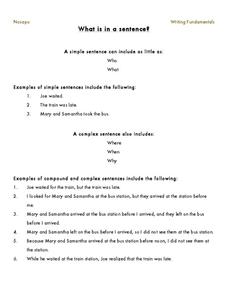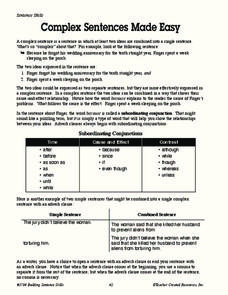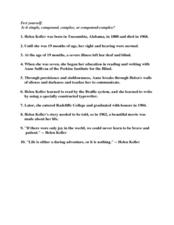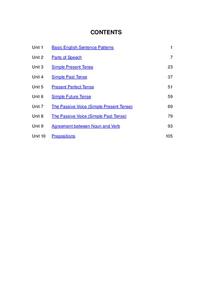Collaborative Learning Project
Simple to Complex Sentences
Such a creative game idea, this activity might actually make grammar fun! Learners play a modified game of connect-four by identifying the grammatical name for different words and phrases and then working them into simple sentences to...
Curated OER
Recognizing Types of Sentences
Examine eleven sentences and identify them as simple sentences, compound sentences, or complex sentences in this grammar worksheet. Use the activity as a quiz, review lesson, or homework assignment.
Nosapo
What Is in a Sentence, Paragraph, and Story?
Language arts is made up of many parts. Learners review the parts of a sentence, as well as how to make a simple sentence into a complex sentence, before examining full paragraphs and identifying the topic, body, and concluding sentence...
Curated OER
The Complex Sentence
Develop the writing skills of your middle and high schoolers with this worksheet on complex, compound, and simple sentences. This resource assumes your learners are familiar with simple and compound sentences, so only the complex...
Houghton Mifflin Harcourt
Kinds of Sentences
Boost understanding of the four types of sentences with several exercises. To start off, read through the provided information about the types of sentences together. This will prepare your class to practice their new knowledge. Then,...
Curated OER
Grammar Lesson Plan: Simple Past vs. Present Perfect
What's the difference between the present perfect and simple past? Have your class practice identifying and using both of these verb tenses through pair activities, whole-class discussion, and a worksheet.
Ms. McLaughlin's Homework Page
Simple, Compound, and Complex Sentences
Find out just how much your pupils know about simple sentences, subjects and predicates, sentence fragments, coordinating and subordinating conjunctions, compound sentences, complex sentences, and more! This review page includes...
Teacher Created Resources
Complex Sentences Made Easy
Support scholars' ability to write complex sentences with a two-page worksheet designed to inform and reinforce. Here, learners obtain a brief overview of what a complex sentence is and how one is made; then apply their new-found...
Curated OER
Sentence Structure: Hellen Keller Biography
Readers identify sentence structure -- simple, compound, complex, compound-complex -- in 10 examples based on Helen Keller's life story.
Curated OER
Sentence Completion 9 Low-Advanced SAT Level
The explanations sheet is the key to a instructional activity that asks learners to choose the best words to complete sentences. The answer and explanations pages not only identify the correct response but offer an extensive explanation...
Curated OER
Simple, Compound, Complex, and Compound-Complex Sentences
What kind of sentence is it? This can be a complex subject, so don't compound the difficulty by skipping over the topic! It's simple, just have your class read and go over the information here and then complete the included exercise.
Curated OER
Simple Sentences
In this grammar worksheet, students identify the subject and predicate in 30 simple and more complex sentences. Students are able to read the detailed directions which are provided.
Curated OER
Basic English Sentence Patterns
A simple set of practice sheets deals with sentence structure and patterns. The 117-page packet includes 10 units of skills, varying from identifying parts of speech in a sentence to writing the correct part to make a sentence...
Curated OER
The Past Tense -- Simple Past
A quick review of the past tense begins this worksheet. It focuses on the simple past, and has a diagram to identify past actions in visual terms. Adding -ed or -ied is explained, and the past forms of to...
K12 Reader
Identifying Adverbs II
Investigate the impact and function of adverbs with a grammar worksheet. Kids look for the adverbs and adverbial phrases in 15 sentences, and then underline the verbs that the adverb modifies.
K12 Reader
Combining Sentences Using Appositives
If learners only use simple sentence structure, their essays can fall flat. Model how to combine short, choppy sentences with appositives to add interest and flow to individuals' writing.
Curated OER
Sentence Patterns I: Locating Subjects and Verbs
Tighten up your class's grammar with this straightforward learning exercise on sentence patterns. After a short review about sentence patterns, clauses, and subjects and verbs, ten questions prompt young writers to identify the parts of...
Curated OER
Sentence Types: "The Americanization of Shadrach Cohen"
Readers identify sentence types with 25 examples based on Bruno Lessing's short story "The Americanization of Shadrach Cohen." For each, they choose from simple, compound, complex, or compound-complex.
Curated OER
Simple and compound sentences
In this simple and compound sentences worksheet, students decide whether sentences are simple or compound sentences. Students also identify homophones, and plurals in sentences.
Kids Learning Station
Adjectives
Enhance your writing with describing words. After reading 12 simple sentences, learners circle the adjectives and underline the nouns they describe. Additionally, they write a few of their own sentences with adjectives at the bottom of...
Curated OER
CTBS Usage Practice #3
In this grammar worksheet, learners identify: topic sentences, simple predicate, simple subjects, and combined multiple sentences. They answer fifteen multiple choice questions.
K12 Reader
Identifying Adjectives
Support your bright young grammarians with identifying adjectives using these simple, yet effective skills practice worksheets. Presenting with a series of 18 sentences children are asked to first circle the...
K12 Reader
Find the Pieces: Predicate Adjective, Noun and Verb
This activity is helpful! Young grammarians review ten simple sentences, each with a subject, linking verb, and predicate adjective, before noting each part of speech appropriately.
K5 Learning
Identifying Nouns (Grade 2)
Find the nouns in 10 sentences with a simple grammar worksheet. After learners read each sentence, they circle each noun and then write their own sentences at the bottom of the page.























